| Listing 1 - 10 of 16 | << page >> |
Sort by
|
Book
ISBN: 9781441911513 9781441911506 1441911502 1282834517 9786612834516 1441911510 Year: 2010 Publisher: New York, NY Springer New York
Abstract | Keywords | Export | Availability | Bookmark
 Loading...
Loading...Choose an application
- Reference Manager
- EndNote
- RefWorks (Direct export to RefWorks)
Metamaterials - artificially structured materials with engineered electromagnetic properties - have enabled unprecedented flexibility in manipulating electromagnetic waves and producing new functionalities. This book details recent advances in the study of optical metamaterials, ranging from fundamental aspects to up-to-date implementations, in one unified treatment. Important recent developments and applications such as superlens and cloaking devices are also treated in detail and made understandable. The planned monograph can serve as a very timely book for both newcomers and advanced researchers in this extremely rapid evolving field.
Physics. --- Optics and Electrodynamics. --- Microwaves, RF and Optical Engineering. --- Optical and Electronic Materials. --- Microwaves. --- Optical materials. --- Physique --- Micro-ondes --- Matériaux optiques --- Optical materials --- Metamaterials --- Metamaterials.
Book
ISBN: 9782287094088 9782287094071 2287094075 Year: 2010 Publisher: Paris Springer Paris
Abstract | Keywords | Export | Availability | Bookmark
 Loading...
Loading...Choose an application
- Reference Manager
- EndNote
- RefWorks (Direct export to RefWorks)
La photonique est déjà présente dans notre vie quotidienne, et on attend maintenant que la manipulation des photons permette aussi le traitement logique des informations. Cependant, l'élément de base qui permet cette manipulation de la lumière, le cristal photonique, est d'une réalisation complexe et mal contrôlée. Dans la course à la maîtrise de la lumière, les structures photoniques naturelles ont beaucoup à nous apprendre. C'est ce que nous montre Serge Berthier qui étudie dans ce livre la structure des écailles des Morphos. Tenant compte de l'essor récent des approches biomimétiques, il présente de manière détaillée plus de dix-huit techniques expérimentales utilisées pour ses analyses, ainsi que les diverses approches théoriques développées pour la modélisation de structures multi-échelles complexes. Première étude quasi-exhaustive des structures fines d'un genre et des propriétés optiques ainsi que colorimétriques générées, ce livre fournit aux entomologistes et aux éthologistes une importante et unique base de données. Il s'adresse en outre aux biologistes et aux physiciens travaillant dans le domaine de la recherche et de l'ingénierie. Les plus jeunes et leurs enseignants y trouveront enfin matière à de nombreux TIPE ou projets d'initiation à la recherche. Plus de 400 images (planches, photographies, schémas) illustrent cet ouvrage grâce auquel les lecteurs pourront découvrir les beautés cachées des ailes de lumières et pénétrer de manière compréhensible le territoire fascinant de la photonique. Serge Berthier est professeur de physique à l'université Paris Diderot ainsi qu'aux Facultés universitaires Notre-Dame de la Paix (Namur, Belgique) et chercheur à l'Institut des NanoSciences de Paris (CNRS, université Pierre et Marie Curie).
Physics. --- Physics, general. --- Optical and Electronic Materials. --- Optics, Optoelectronics, Plasmonics and Optical Devices. --- Zoology. --- Biophysics and Biological Physics. --- Physics. --- Zoology. --- Optical materials. --- Physique --- Zoologie --- Matériaux optiques
Book
ISBN: 9783642025891 9783642025884 Year: 2010 Publisher: Berlin, Heidelberg Springer Berlin Heidelberg
Abstract | Keywords | Export | Availability | Bookmark
 Loading...
Loading...Choose an application
- Reference Manager
- EndNote
- RefWorks (Direct export to RefWorks)
Learning Solid State Physics involves a certain degree of maturity, since it involves tying together diverse concepts from many areas of physics. The objective is to understand, in a basic way, how solid materials behave. To do this one needs both a good physical and mathematical background. One definition of Solid State Physics is it is the study of the physical (e.g. the electrical, dielectric, magnetic, elastic, and thermal) properties of solids in terms of basic physical laws. In one sense, Solid State Physics is more like chemistry than some other branches of physics because it focuses on common properties of large classes of materials. It is typical that Solid State Physics emphasizes how physics properties link to electronic structure. We have retained the term Solid Modern solid state physics came of age in the late thirties and forties and is now is part of condensed matter physics which includes liquids, soft materials, and non-crystalline solids. This solid state/condensed matter physics book begins with three broad areas: (1) How and why atoms bind together to form solids, (2) Lattice vibrations and phonons, and (3) Electrons in solids. It then applies these areas to (4) Interactions especially of electrons with phonons, (5) Metals, the Fermi surface and alloys, (6) Semiconductors, (7) Magnetism, (8) Superconductivity, (9) Dielectrics and ferroelectrics, (10) Optical properties, (11) Defects, and (12) Certain other modern topics such as layered materials, quantum Hall effect, mesoscopics, nanophysics, and soft condensed matter. For this 2nd addition new material has been added on the evolution of BEC to BCS phenomena, conducting polymers, graphene, highly correlated electrons, iron pnictide superconductors, light emitting diodes, N-V centers, nanomagnetism, negative index of refraction, optical lattices, phase transitions, phononics, photonics, plasmonics, quantum computing, solar cells, spin Hall effect, and spintronics. The major addition to this 2nd edition is an extensive solutions manual, in which all the text problems are discussed. The problems in our book cover a wide range of difficulty. The solutions in this manual are expected to show what we expect to get out of the problems. In the manual, we have also included a brief summary of solid state physics which should help you get focused on problem solving. We have also included "folk theorems" to remind about the essence of the physics without the mathematics.
Physics. --- Condensed Matter Physics. --- Solid State Physics. --- Spectroscopy and Microscopy. --- Electronics and Microelectronics, Instrumentation. --- Optical and Electronic Materials. --- Electronics. --- Optical materials. --- Physique --- Electronique --- Matériaux optiques --- Solid state physics.
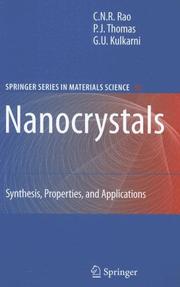
ISBN: 9783540687511 9783540687528 9783642088230 Year: 2007 Publisher: Berlin, Heidelberg Springer-Verlag Berlin Heidelberg
Abstract | Keywords | Export | Availability | Bookmark
 Loading...
Loading...Choose an application
- Reference Manager
- EndNote
- RefWorks (Direct export to RefWorks)
Nanocrystals and Their Mesoscopic Organization is an up-to-date monograph on an important aspect of nanoscience and technology. It opens with an elegant introduction including a brief historical account. Emphasis is then given to diverse synthetic methods, both chemical and physical, in addition to modern hybrid methods. The orientation shifts gradually to properties of nanocrystals that evolve with size; detailed discussions are to be found on mesoscalar assemblies in different dimensions, special cases of core-shell and magic nuclearity nanocrystals. The authors also address applications of nanocrystals, carefully separating out potential applications and those that have already emerged, and cite around 900 references from the literature, most from the last decade. Tables providing information at a glance and schematic diagrams at relevant places, make the monograph appealing to read. Occasionally, the reader is reminded of the contributions of celebrated past masters such as Michael Faraday. In summary, the monograph serves as a general introduction as well as a handy reference for the entire community of researchers and practitioners.
Nanotechnology --- Materials science --- Engineering --- Optical materials --- Electronic materials --- Physical chemistry --- Physics --- Natural philosophy --- Philosophy, Natural --- Physical sciences --- Dynamics --- Chemistry, Theoretical --- Theoretical chemistry --- Chemistry --- Optics --- Materials --- Construction --- Industrial arts --- Technology --- Material science --- Molecular technology --- Nanoscale technology --- High technology
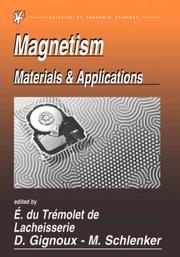
ISBN: 9780387230634 0387230009 9780387230009 9780387230637 9786613438256 1283438259 0387230637 0387699104 Year: 2005 Publisher: Springer New York
Abstract | Keywords | Export | Availability | Bookmark
 Loading...
Loading...Choose an application
- Reference Manager
- EndNote
- RefWorks (Direct export to RefWorks)
This book treats permanent magnet (hard) materials, magnetically soft materials for low-frequency applications and for high-frequency electronics, magnetostrictive materials, superconductors, magnetic-thin films and multilayers, and ferrofluids. Chapters are dedicated to magnetic recording, the role of magnetism in magnetic resonance imaging (MRI), and instrumentation for magnetic measurements. .
Physics. --- Magnetism, Magnetic Materials. --- Condensed Matter Physics. --- Optical and Electronic Materials. --- Magnetism. --- Optical materials. --- Physique --- Magnétisme --- Matériaux optiques --- Magnetism --- Magnetic materials --- Physics --- Physical Sciences & Mathematics --- Electricity & Magnetism --- Magnetic materials. --- Condensed matter. --- Electronic materials. --- Materials --- Mathematical physics --- Electricity --- Magnetics --- Optics --- Electronic materials --- Condensed materials --- Condensed media --- Condensed phase --- Materials, Condensed --- Media, Condensed --- Phase, Condensed --- Liquids --- Matter --- Solids --- Magnetismo.
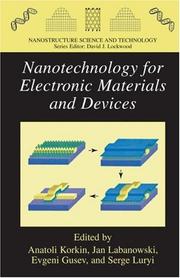
ISBN: 1282823302 9786612823305 0387499652 9780387499659 0387233490 9780387233499 1441936122 Year: 2006 Publisher: New York : Springer,
Abstract | Keywords | Export | Availability | Bookmark
 Loading...
Loading...Choose an application
- Reference Manager
- EndNote
- RefWorks (Direct export to RefWorks)
This book is designed as an introduction for graduate students, engineers, and researchers who want to understand the current status and future trends of micro- and nano-electronic materials and devices. It also serves as an essential reference for nanotechnology "gurus" who need to keep abreast of the latest directions and challenges in microelectronic technology. Written by leading experts in each research area the viewpoints presented can help to foster further research and cross-disciplinary interactions required to surmount the barriers facing future generations of technology design. .
Molecular electronics. --- Nanotechnology. --- Electronics --- Materials. --- Electronic materials --- Molecular technology --- Nanoscale technology --- Molectronics --- Electronics -- Materials. --- Materials science. --- Electronics. --- Microelectronics. --- Optical materials. --- Electronic materials. --- Materials Science. --- Electronics and Microelectronics, Instrumentation. --- Optical and Electronic Materials. --- High technology --- Microelectronics --- Nanotechnology --- Optics --- Materials --- Electrical engineering --- Physical sciences --- Microminiature electronic equipment --- Microminiaturization (Electronics) --- Microtechnology --- Semiconductors --- Miniature electronic equipment
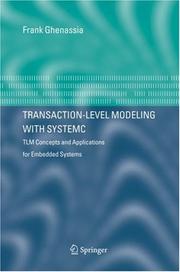
ISBN: 1280459611 9786610459612 0387262334 0387262326 9780387262321 1441938753 9780387262338 Year: 2005 Publisher: Boston, MA Springer
Abstract | Keywords | Export | Availability | Bookmark
 Loading...
Loading...Choose an application
- Reference Manager
- EndNote
- RefWorks (Direct export to RefWorks)
Currently employed at STMicroelectronics, Transactional-Level Modeling (TLM) puts forward a novel SoC design methodology beyond RTL with measured improvements of productivity and first time silicon success. The SystemC consortium has published the official TLM development kit in May 2005 to standardize this modeling technique. The library is flexible enough to model components and systems at many different levels of abstractions: from cycle-accurate to untimed models, and from bit-true behavior to floating-point algorithms. However, careful selection of the abstraction level and associated methodology is crucial to ensure practical gains for design teams. Transaction-Level Modeling with SystemC presents the formalized abstraction and related methodology defined at STMicroelectronics, and covers all major topics related to the Electronic System-Level (ESL) industry: - TLM modeling concepts - Early embedded software development based on SoC virtual prototypes - Functional verification using reference models - Architecture analysis with mixed TLM and cycle accurate platforms - Unifying TLM and RTL with platform automation tools Complementary to the book, open source code to put this approach into practice is available on several Internet sites as indicated in the first chapter.
Systems on a chip --- Application specific integrated circuits --- C (Computer program language) --- System design. --- Design and construction. --- Design, System --- Systems design --- Electronic data processing --- System analysis --- SOC design --- Systems on chip --- Embedded computer systems --- System Design --- Design and construction --- Logische schakelingen. --- Computer engineering. --- Electronics. --- Engineering design. --- Optical materials. --- Electrical Engineering. --- Electronics and Microelectronics, Instrumentation. --- Engineering Design. --- Optical and Electronic Materials. --- Optics --- Materials --- Design, Engineering --- Engineering --- Industrial design --- Strains and stresses --- Electrical engineering --- Physical sciences --- Computers --- Design --- Electrical engineering. --- Microelectronics. --- Electronic materials. --- Electronic materials --- Microminiature electronic equipment --- Microminiaturization (Electronics) --- Electronics --- Microtechnology --- Semiconductors --- Miniature electronic equipment --- Electric engineering --- Systems on a chip - Design and construction --- Application specific integrated circuits - Design and construction
Book
ISBN: 9780387755779 0387755764 9780387755762 9786611950071 1281950076 0387755772 Year: 2008 Publisher: New York : Springer,
Abstract | Keywords | Export | Availability | Bookmark
 Loading...
Loading...Choose an application
- Reference Manager
- EndNote
- RefWorks (Direct export to RefWorks)
Nanofabrication: Principles, Capabilities and Limits presents a one-stop description at the introductory level on most technologies that have been developed which are capable of making structures below 100nm. Principles of each technology are introduced and illustrated with minimum mathematics involved. The capabilities of each technology in making sub-100nm structures are described. The limits of preventing a technology from further going down the dimensional scale are analyzed. Drawing upon years of practical experience and using numerous examples, Zheng Cui covers state-of-the art technologies in nanofabrication including: Photon-based lithography Charged particle beams lithography Nanofabrication using scanning probes Nanoscale replication Nanoscale pattern transfer Indirect nanofabrication Nanofabrication by self-assembly Nanofabrication: Principles, Capabilities and Limits will serve as a practical guide and first-hand reference for researchers and practitioners working in nanostructure fabrication and also provides a "tool box" of various techniques that can be easily adapted in different fields of applications. Written for: Nanoscience and nanotechnology researchers and engineers, technical professionals and academic researchers in the fields of electrtonics, mechanical engineering, and chemical engineering.
Materials Science. --- Nanotechnology. --- Materials Science, general. --- Continuum Mechanics and Mechanics of Materials. --- Optical and Electronic Materials. --- Materials. --- Optical materials. --- Matériaux --- Matériaux optiques --- Nanotechnologie --- Materials Science --- Technology - General --- Chemical & Materials Engineering --- Engineering & Applied Sciences --- Nanostructured materials. --- Nanomaterials --- Nanometer materials --- Nanophase materials --- Nanostructure controlled materials --- Nanostructure materials --- Ultra-fine microstructure materials --- Molecular technology --- Nanoscale technology --- Materials science. --- Continuum mechanics. --- Electronic materials. --- High technology --- Microstructure --- Nanotechnology --- Mechanics. --- Mechanics, Applied. --- Solid Mechanics. --- Optics --- Materials --- Applied mechanics --- Engineering, Mechanical --- Engineering mathematics --- Classical mechanics --- Newtonian mechanics --- Physics --- Dynamics --- Quantum theory --- Engineering --- Engineering materials --- Industrial materials --- Engineering design --- Manufacturing processes --- Electronic materials --- Material science --- Physical sciences
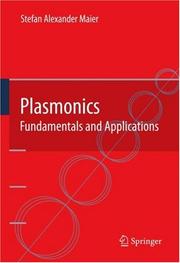
ISBN: 9780387331508 9780387378251 0387331506 1441941134 9786610865888 0387378251 1280865881 Year: 2007 Publisher: New York, N.Y. Springer
Abstract | Keywords | Export | Availability | Bookmark
 Loading...
Loading...Choose an application
- Reference Manager
- EndNote
- RefWorks (Direct export to RefWorks)
Considered one of the major fields of photonics of the beginning 21st century, plasmonics offers the potential to confine and guide light below the diffraction limit and promises a new generation of highly miniaturized photonic devices. Offering both a comprehensive introduction to the field and an extensive overview of the current state of the art, "Plasmonics: Fundamentals and Applications" should be of great value to the newcomer and to the experienced researcher. The first part of the book describes the fundamentals of this research area, starting with a review of Maxwell’s equations in a form suited to the description of metals. Subsequent chapters introduce the two major ingredients of plasmonics, surface plasmon polaritons at metallic interfaces and localized plasmons in nanostructures. The mathematics of their description, excitation and imaging of the modes are discussed. This part closes with a presentation of electromagnetic surface waves at lower frequencies in the THz and microwave regime, comprising both spoof or designer plasmons and surface phonon polaritons. Building on the fundamentals, the second part discusses some of the most prominent applications of plasmons: Plasmon waveguides, extraordinary transmission through aperture arrays, sensing and surface enhanced Raman scattering, spectroscopy as well as metamaterials. Exemplary studies in each of these fields taken from the original literature are presented.
Electronics and optics of solids --- Plasmons (Physics) --- Photonics. --- Photonics --- Plasmons --- Photonique --- EPUB-LIV-FT LIVCHIMI SPRINGER-B --- Optical materials. --- Nanotechnology. --- Surfaces (Physics). --- Materials. --- Optical and Electronic Materials. --- Condensed Matter Physics. --- Surfaces and Interfaces, Thin Films. --- Metallic Materials. --- Engineering --- Engineering materials --- Industrial materials --- Engineering design --- Manufacturing processes --- Physics --- Surface chemistry --- Surfaces (Technology) --- Molecular technology --- Nanoscale technology --- High technology --- Optics --- Materials --- Electronic materials. --- Condensed matter. --- Materials—Surfaces. --- Thin films. --- Metals. --- Metallic elements --- Chemical elements --- Ores --- Metallurgy --- Films, Thin --- Solid film --- Solid state electronics --- Solids --- Coatings --- Thick films --- Condensed materials --- Condensed media --- Condensed phase --- Materials, Condensed --- Media, Condensed --- Phase, Condensed --- Liquids --- Matter --- Electronic materials
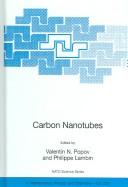
ISBN: 9781402045745 1402045727 9781402045721 1402045735 9786611107536 1281107530 1402045743 Year: 2006 Volume: v. 222 Publisher: Dordrecht Springer
Abstract | Keywords | Export | Availability | Bookmark
 Loading...
Loading...Choose an application
- Reference Manager
- EndNote
- RefWorks (Direct export to RefWorks)
It is about 15 years that the carbon nanotubes have been discovered by Sumio Iijima in a transmission electron microscope. Since that time, these long hollow cylindrical carbon molecules have revealed being remarkable nanostructures for several aspects. They are composed of just one element, Carbon, and are easily produced by several techniques. A nanotube can bend easily but still is very robust. The nanotubes can be manipulated and contacted to external electrodes. Their diameter is in the nanometer range, whereas their length may exceed several micrometers, if not several millimeters. In diameter, the nanotubes behave like molecules with quantized energy levels, while in length, they behave like a crystal with a continuous distribution of momenta. Depending on its exact atomic structure, a single-wall nanotube –that is to say a nanotube composed of just one rolled-up graphene sheet– may be either a metal or a semiconductor. The nanotubes can carry a large electric current, they are also good thermal conductors. It is not surprising, then, that many applications have been proposed for the nanotubes. At the time of writing, one of their most promising applications is their ability to emit electrons when subjected to an external electric field. Carbon nanotubes can do so in normal vacuum conditions with a reasonable voltage threshold, which make them suitable for cold-cathode devices.
materiaalkennis --- halfgeleiders --- Electronics and optics of solids --- nanotechniek --- transistoren --- Materials sciences --- Electrical engineering --- materialen (technologie) --- Nanostructured materials --- Nanotubes --- Carbon --- Tubes --- Nanomatériaux --- Carbone --- Congresses --- Congresses. --- Congrès --- EPUB-LIV-FT LIVCHIMI SPRINGER-B --- Materials. --- Engineering. --- Nanotechnology. --- Optical materials. --- Materials Science, general. --- Nanotechnology and Microengineering. --- Structural Materials. --- Optical and Electronic Materials. --- Optics --- Materials --- Molecular technology --- Nanoscale technology --- High technology --- Construction --- Industrial arts --- Technology --- Engineering --- Engineering materials --- Industrial materials --- Engineering design --- Manufacturing processes --- Materials science. --- Structural materials. --- Electronic materials. --- Electronic materials --- Architectural materials --- Architecture --- Building --- Building supplies --- Buildings --- Construction materials --- Structural materials --- Material science --- Physical sciences --- NATO
| Listing 1 - 10 of 16 | << page >> |
Sort by
|

 Search
Search Feedback
Feedback About UniCat
About UniCat  Help
Help News
News